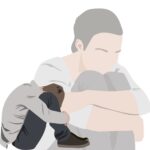Agoraphobia is the fear that someone will get hurt if they are in a public or busy place where they can’t easily get out or where help might not be easy to find. It is marked by the fear that a panic attack or signs similar to a panic attack could happen in these scenarios. People who have agoraphobia try to stay away from these kinds of places or events.
People with agoraphobia often also have panic disorder, which causes a lot of suffering. A study was done to look at the differences in symptoms and lengths of treatment between people with panic disorder (PD) and people without agoraphobia (PDA). The results showed that the PDA group had worse anxiety and mood problems than the PD group, according to the results. People who had PDA were more likely to be younger when the symptoms started, to take benzodiazepines for longer periods of time, and to be treated with antipsychotics for longer periods of time. The agoraphobia subscale was linked to panic attacks, sadness, anxiety, and the amount of time someone had been taking drugs. The results show that people with PDA had worse panic symptoms, more serious mental disorders, and a worse course of their illness than people with PD.
According to the National Institute of Mental Health, 1.3% of people experience agoraphobia at some point in their lives, and about 0.9% of people experience it each year. Agoraphobia affects about the same number of men and women each year: 0.8% of men and 0.9% of women.
Since this condition can be dreadful for those who experience it and it can have adverse effects, it is important to diagnose it and seek the required treatment as soon as possible. The following criteria and features, as highlighted by the DSM 5 TR, can help diagnose agoraphobia:
Diagnostic Criteria
A. A lot of worry or fear about two or more of the five events below:
1. Taking public transportation (like cars, buses, trains, ships, and planes).
2. Being in open places like shopping malls, bridges, parking lots, etc.
3. Being in small spaces (like stores, theaters, and movie houses).
4. Having to wait in line or be in a crowd.
5. Being by yourself outside the house.
B. The person avoids or fears these situations because they think it might be hard to get out of them or that they might not be able to get help if they start having panic-like symptoms or other symptoms that make them unable to do things or look bad, like fear of falling for older people or fear of urination.
C. Most of the time, agoraphobic situations make people feel scared or anxious.
D. The agoraphobic situations are actively avoided, need to be with someone else, or are experienced with a lot of fear or anxiety.
E. The person’s fear or worry is out of proportion to the danger they are in and the social and cultural setting.
F. The fear, worry, or reluctance doesn’t go away and usually lasts for at least six months.
It’s clinically significant discomfort or impairment in social, professional, or other important areas of performance because of fear, anxiety, or avoidance.
H. The fear, worry, or avoidance is too much if there is another medical condition present, such as inflammatory bowel disease or Parkinson’s disease.
I. The fear, anxiety, or avoidance isn’t better explained by the symptoms of another mental disorder. For example, the symptoms aren’t limited to a certain type of phobia or situational phobia; they don’t just happen in social situations (as in social anxiety disorder); they aren’t just about obsessions (as in obsessive-compulsive disorder); they aren’t just about perceived flaws or defects in physical appearance (as in body dysmorphic disorder); they aren’t just about body dysmorphic disorder; they can also be caused by traumatic events (as in post-traumatic stress disorder); or they are not just about fear of separation (as in separation anxiety disorder).
Note: Agoraphobia can be identified even if someone also has panic disorder. If a person shows signs of both panic disorder and agoraphobia, they should be given both labels.
Diagnostic Features
- As a result of being in or thinking about many diverse circumstances, agoraphobia causes strong anxiety or worry (Criterion A).
- Signs must appear in two of the five cases below to diagnose: 1) Public transportation like vehicles, buses, trains, ships, or aircraft; 2) Open areas like parking lots, markets, or bridges; 3) Closed locations like stores, theaters, or movie theaters; 4) Waiting in line or in a crowd; or 5) Being outside alone.
- There are more examples than presented; one may be terrified in others.
- When these occurrences produce anxiety and worry, people assume something unpleasant will happen (Criterion B).
- Panic-like symptoms or other symptoms that make things hard or humiliating make individuals think they cannot get out of the circumstance or find help.
- “Panic-like symptoms” are any of the 13 panic attack symptoms. These include dizziness, weakness, and death anxiety.
- Other symptoms that make it hard to perform tasks or look beautiful include illness, inflammatory bowel symptoms, and, in older individuals, a fear of falling or, in youth, being lost and bewildered.
- Dread can come before or during an agoraphobic circumstance and depends on how near someone is to the object they dread.
- The dread or concern might manifest as a full- or limited-symptom panic attack.
- The person feels anxiety or worry almost every time they encounter their phobia.
- A person who only gets nervous once in five times when waiting in line is not diagnosed with agoraphobia.
- The individual deliberately avoids the situation, needs to be with someone, or is afraid or worried if they cannot or will not.
- Active avoidance is avoiding events that make individuals nervous.
- People who avoid situations might adjust their daily habits, work near home to avoid public transit or order food delivery to avoid shops and supermarkets.
- Mental avoidance includes employing diversions to cope with agoraphobia.
- Avoidance can become so severe that the person cannot leave home.
- With a spouse, friend, or health professional, people can better handle their fears.
- The person may also sit near public transit exits or at the movies to feel safer in these scenarios.
- The person must be fearful, worried, or avoid situations out of proportion to the threat and social and cultural environment (Criterion E).
- Fears like not leaving the house during a storm are legitimate.
- It is vital to distinguish between illogical, clinically relevant agoraphobic worries and unsafe scenarios like wandering in a parking lot or catching the bus in a high-crime neighborhood.
- In diverse cultures and social contexts, avoidance can be difficult to define.
- In certain countries, observant Muslim women can avoid leaving the house alone without being considered agoraphobic.
- Second, older persons are more inclined to blame age-related constraints for their anxieties. Less likely to think their worries are disproportionate to the risk.
- Third, panic attacks and other bodily symptoms make agoraphobics fear they are in danger.
- Agoraphobia is only diagnosed if the fear, anxiety, or avoidance lasts (Criterion F) and interferes with social, professional, or other vital aspects of life (Criterion G).
- “Usually lasting for 6 months or more” excludes short-term difficulties.
I am a passionate and knowledgeable psychologist, with a Master of Philosophy (MPhil) in Psychology specializing in Counseling Psychology. Through my writing, I share my insights and thoughts on various psychiatric disorders, conduct analysis on films that touch on psychological issues, and explore other topics related to psychology, while also providing valuable information to psychology enthusiasts, students as well the general community.





